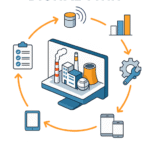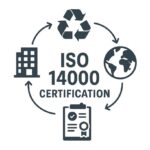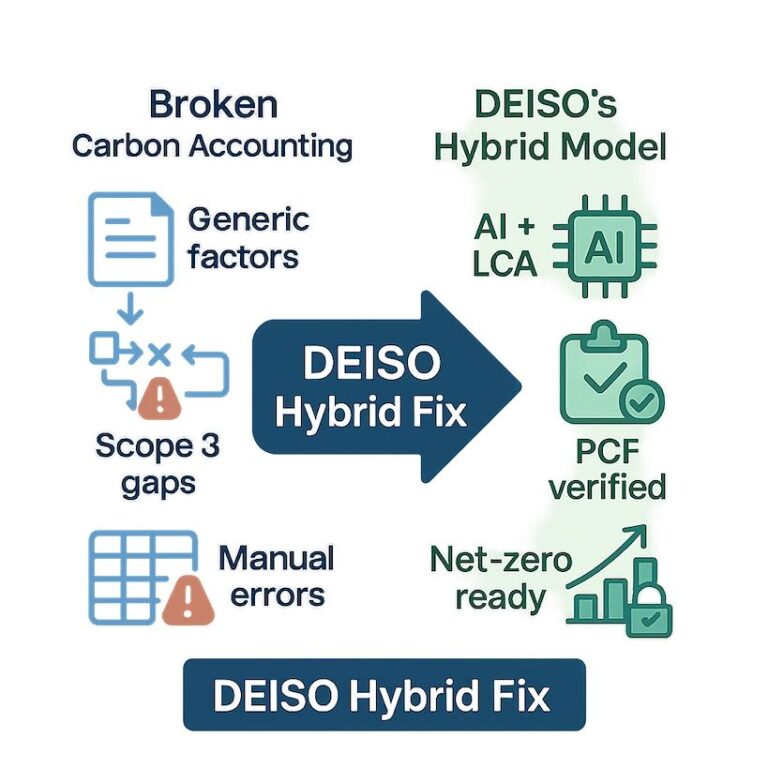
🟩 Introduction — The Carbon Accounting Conundrum
Across industries, sustainability has shifted from a corporate buzzword to a strategic necessity. Yet, one crucial domain remains fundamentally flawed: carbon accounting. Despite bold net-zero targets, most companies rely on outdated, error-prone methodologies that misrepresent their true emissions profile, especially for Scope 3.
DEISO, a Japan-based environmental intelligence firm, has developed a breakthrough: a hybrid carbon accounting model that fuses science-based LCA methods, AI-powered analytics, and expert validation. It’s not a patch—it’s a structural fix for what’s broken in today’s carbon reporting systems.
🟩 Section 1: Why Carbon Accounting is Fundamentally Broken
While businesses and governments scramble to reduce emissions, carbon accounting practices remain decades behind. Many still:
Use spreadsheets or outdated software that is prone to manual errors.
Rely on generic emission factors that fail to capture regional, industry-specific, or product-level differences.
Struggle with Scope 3 data, often filling gaps with assumptions instead of facts.
Operate in silos, lacking integration between procurement, sustainability, finance, and compliance teams.
Worse still, current practices often reduce carbon accounting to a mere check-the-box exercise, thereby undermining its potential to drive real-world impact. This creates a dangerous illusion of progress, with over- or under-estimations reaching as high as 30–40% in large enterprises.
The brokenness isn’t in the intention—it’s in the framework.
🟩 Section 2: Trends and Data Insights – The Pressure is Real
The carbon accounting landscape is undergoing a seismic transformation driven by regulation, capital markets, and climate science. A few data points underscore the urgency:
According to the CDP, 75% of global emissions reported by companies fall under Scope 3, yet less than 50% disclose them with any accuracy.
The EU’s Corporate Sustainability Reporting Directive (CSRD) requires verified, product-level carbon data, especially for goods crossing borders.
Investment firms managing over $100 trillion now demand auditable, science-based carbon disclosures for ESG compliance.
In Japan, where DEISO operates, the GX League and new MOE guidelines further pressure companies to upgrade carbon reporting across their supply chains.
Visualization is required for this section. Please instruct me to generate the visualization concept.
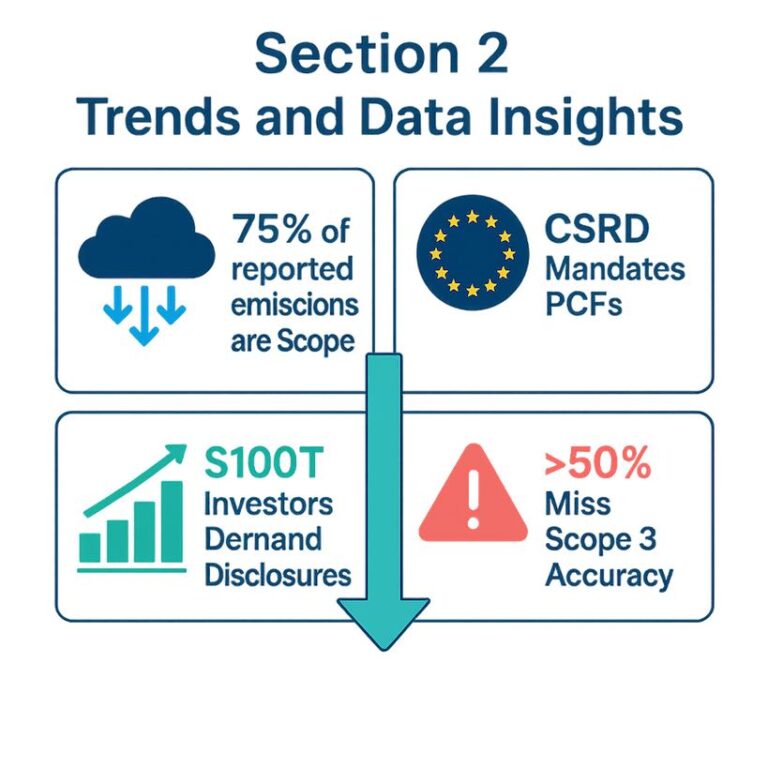
🟩 Section 3: DEISO’s Hybrid Model — Strategic, Verified, Intelligent
At DEISO, we believe carbon accounting must evolve from a passive report card to a proactive strategy. Our hybrid model combines three critical layers:
Life Cycle Assessment (LCA) & Product Carbon Footprinting (PCF):
Grounded in ISO 14067 and EN 15804, we calculate accurate cradle-to-gate or cradle-to-grave emissions using global databases such as ecoinvent, Sphera/GaBi, and Agribalyse.AI-Driven Emissions Data Intelligence:
DEISO’s proprietary AI extracts, classifies, and updates emission factors from diverse sources, including scientific journals, supplier reports, and regulatory databases.Expert Validation and Human Oversight:
Our sustainability professionals cross-verify AI-calculated results to ensure they align with your business model, geographic scope, and regulatory environment.
Key Differentiators:
Verifiable outputs for EPDs and GHG disclosures
Full integration with OpenLCA, SimaPro, and DEISO Visly™
Capability to run scenario analyses for decarbonization pathways
🟩 Section 4: Technology Stack Behind the Model
Unlike rigid off-the-shelf software, DEISO’s model is designed to adapt across various industries, regulatory levels, and corporate maturity levels. Here’s a closer look at our stack:
🧠 AI Carbon Engine
Extracts accurate, real-time emission factors
Classifies data by flow, medium, and geography
Auto-updates regulatory thresholds (e.g., IPCC 2021)
🧩 LCA Modeling Platforms
Compatibility with SimaPro, OpenLCA, GaBi
Integration of process-level data across Scope 1–3
📊 DEISO Visly™
Interactive dashboards for emissions insight
Drill-down views for procurement, product lines, or countries
Scenario modeling for decarbonization planning
🔒 Compliance & Verification Framework
Templates for EPDs, ISO/GHG reports
Alignment with CSRD, ISSB, and regional frameworks
Visualization is required for this section. Please instruct me to generate the visualization concept.
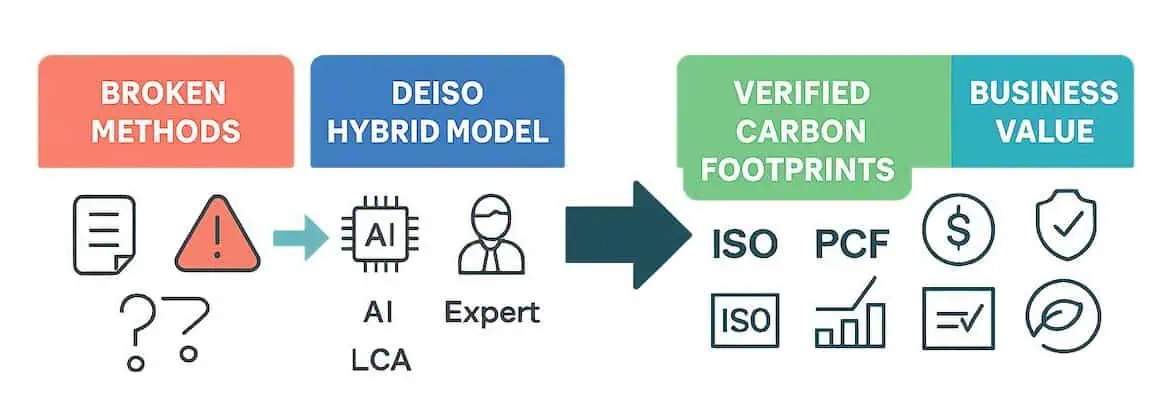
🟩 Section 5: Real-World Impact – A Tokyo Case Study
Client Profile: Mid-sized electronics manufacturer in Tokyo
Challenge: Greenwashing allegations due to inconsistent Scope 3 disclosures
Engagement: 3-month project using DEISO’s hybrid model
Outcome Highlights:
+47% improvement in carbon footprint accuracy
Developed three certified Product Carbon Footprints (PCFs)
Enabled full alignment with ISO 14067
Integrated footprint outputs into an EPD verified by an external program operator
Empowered internal teams with DEISO’s training modules on carbon accounting
This transformation was not just a technical fix—it became a reputation-saving pivot for the company’s ESG strategy.
🟩 Section 6: Conclusion – Fix Carbon Accounting Before It Costs You
Carbon accounting is no longer a niche reporting task—it’s central to investor confidence, market access, and long-term climate resilience. Yet, most systems in use today are not just outdated—they’re misleading.
DEISO’s hybrid model offers clarity, accuracy, and verification that traditional approaches can’t. Backed by LCA science, smart automation, and expert oversight, it’s designed to serve businesses that are serious about climate leadership, not just compliance.
Stop approximating. Start transforming.
🟩 Section 7: Strong Call to Action (CTA)
🚀 Start Your Carbon Accuracy Journey with DEISO
If your business is still relying on spreadsheets, generic emission factors, or unverified Scope 3 estimates, it’s time to upgrade. Industry leaders trust DEISO’s hybrid carbon accounting models to deliver compliance, precision, and strategic clarity.
🎯 Let us help you future-proof your sustainability reporting.
📞 Contact our expert team today to:
Schedule a consultation
Explore our hybrid methodology
Request a tailored demo
📧 Email: info@dei.so
🌐 Website: https://dei.so



